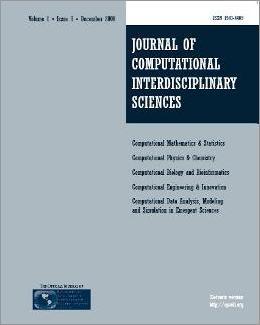
Editorial Office:
Management:
R. S. Oyarzabal
Technical Support:
D. H. Diaz
M. A. Gomez
W. Abrahão
G. Oliveira
Publisher by Knobook Pub


Editorial Office:
Management:
R. S. Oyarzabal
Technical Support:
D. H. Diaz
M. A. Gomez
W. Abrahão
G. Oliveira
Publisher by Knobook Pub
doi: 10.6062/jcis.2012.03.02.0053(Free PDF)
Giordano N., d’Ovidio F., Danø S., Sørensen P. G., and De Monte S.
Fermenting S. cerevisiae cells suspensions undergo synchronized metabolic oscillations whose amplitude and frequency depends on the population density. The asymptotic population-level dynamics is qualitatively and quantitatively accounted for by mathematical models describing the intracellular glycolytic oscillations and the coupling through the external medium. Such dynamical systems often display low-dimensional dynamics for the parameters that quantitatively fit the experimental observations. However, the high dimensionality of the chemical space and the possible existence of intermingled time scales can potentially support more complex dynamics, in particular when the system is perturbed by external forcings. Here, we explore experimentally and by means of numerical models the response of cellular populations to different kinds of periodic forcing: resonant forcing of diluted, nonoscillating populations and strongly nonresonant forcing of populations in oscillating regimes with different dynamical features. We show that, in all cases, low-dimensional semi-quantitative models reproduce the observed dynamics. Both a nonlinear analysis of the experimental time series and the models indicate that complex-looking time series correspond to quasiperiodic and not to chaotic regimes. The fact that low-dimensional dynamical systems are able to reproduce the response of biological populations in different regimes of external periodic forcing supports the use of theoretical models for inquiring the dynamical behaviour of collectively oscillating cells.
glycolytic oscillations, forced oscillations, quasiperiodicity in biological populations, complex cellular dynamics, cell synchronization, dynamical quorum sensing.
[1] CHANCE B, ESTABROOK RW & GHOSH AK. 1964. Damped sinu- soidal oscillations of cytoplasmic reduced pyridine nucleotide in yeast cells. Proc. Natl. Acad. Sci. U.S.A., 51: 1244-1251.
[2] GOLDBETER A. 1996. Biochemical Oscillations and Cellular Rhythms. Cambridge Univ. Press, Cambridge, U.K.
[3] DANØ S, SØRENSEN PG & HYNNE F. 1999. Sustained oscillations in living cells. Nature, 402(6759): 320-322.
[4]KLEVECZ RR, BOLEN J, FORREST G & MURRAY DB. 2004. A genomewide oscillation in transcription gates DNA replication and cell cycle. Proc. Natl. Acad. Sci. U.S.A., 101(5): 1200-1205,February.
[5] STRICKER J, COOKSON S, BENNETT MR, MATHER WH, TSIMRING LS & HASTY J. 2008. A fast, robust and tunable synthetic gene oscillator. Nature, 456(7221): 516-519.
[6] TU BP & MCKNIGHT SL. 2006. Metabolic cycles as an underlying basis of biological oscillations. Nat. Rev. Mol. Cell Biol., 7(9): 696-701.
[7] HYNNE F, DANØ S & SØRENSEN PG. 2001. Full-scale model of glycolysis in Saccharomyces cerevisiae. Biophys. Chem., 94(1-2): 121-163.
[8] DE MONTE S, D’OVIDIO F, DANØ S & SØRENSEN PG. 2007. Dynamical quorum sensing: Population density encoded in cellular dynamics. Proc. Natl. Acad. Sci. U.S.A., 104(47): 18377-18381.
[9] WINFREE A. 2001. The Geometry of Biological Time. Springer 2nd ed., New York.
[10] NIELSEN K, SØRENSEN PG, HYNNE F & BUSSE HG. 1998. Sustained oscillations in glycolysis: an experimental and theoretical study of chaotic and complex periodic behavior and of quenchingo of simple oscillations. Biophys. Chem., 72(1-2): 49-62.
[11] BOITEUX A, GOLDBETER A & HESS B. 1975. Control of oscillating glycolysis of yeast by stochastic, periodic, and steady source of substrate: a model and experimental study. Proc. Natl. Acad. Sci. U.S.A., 72(10): 3829-3833.
[12] MARKUS M, KUSCHMITZ D & HESS B. 1984. Chaotic dynamics in yeast glycolysis under periodic substrate input flux. FEBS Lett., 172(2): 235-238.
[13] MARKUS M, KUSCHMITZ D & HESS B. 1985. Properties of strange attractors in yeast glycolysis. Biophys. Chem., 22(1-2): 95-105.
[14] MARKUS M & HESS B. 1984. Transitions between oscillatory modes in a glycolytic model system. Proc. Natl. Acad. Sci. U.S.A., 81(14): 4394-4398.
15] DI CERA E, PHILLIPSON PE & WYMAN J. 1989. Limit-cycle oscillations and chaos in reaction networks subject to conservation of mass. Proc. Natl. Acad. Sci. U.S.A., 86(1): 142-146.
[16] MARTINEZ DE LA FUENTE I, MARTINEZ L, VEGUILLAS J & AGUIRREGABIRIA JM. 1996. Quasiperiodicity route to chaos in a biochemical system. Biophys. J., 71(5): 2375-2379.
[17] GHOSH AK, CHANCE B & PYE EK. 1971. Metabolic coupling and synchronization of NADH oscillations in yeast cell populations. Biochem Biophys, 145(1): 319-331.
[18] PIKOVSKY A, ROSENBLUM M & KURTHS J. 2001. Synchronization: a universal concept in nonlinear sciences. Cambridge Univ. Press, Cambridge, U.K.
[19] MONDRAGON-PALOMINO O, DANINO T, SELIMKHANOV J, TSIMRING L & HASTY J. 2011. Entrainment of a population of synthetic genetic oscillators. Science, 333(6047): 1315-1319.
[20] PLETZER B, KERSCHBAUM H & KLIMESCH W. 2010. When frequencies never synchronize: the golden mean and the resting EEG. Brain Res., 1335: 91-102.
[21] HALD BO & SØRENSEN PG. 2010. Modeling diauxic glycolytic oscillations in yeast. Biophys. J., 99(10): 3191-3199, November.
[22] KLOSTER A & OLSEN LF. 2012. Oscillations in glycolysis in Saccharomyces cerevisiae: the role of autocatalysis and intracellular ATPase activity. Biophys. Chem., 165-166: 39-47, May.
[23] DANØ S, MADSEN MF & SØRENSEN PG. 2007. Quantitative characterization of cell synchronization in yeast. Proc. Natl. Acad. Sci. U.S.A., 104(31): 12732-12736.
[24] DANØS, HYNNE F, DE MONTE S, D’OVIDIO F, SØRENSEN PG & WESTERHOFF H. 2001. Synchronization of glycolytic oscillations in a yeast cell population. Faraday Discuss., 120: 261-276.
[25] MATTHEWS PC & STROGATZ SH. 1990. Phase diagram for the collective behavior of limit-cycle oscillators. Phys. Rev. Lett., 65(14): 1701-1704.
[26] LI CM & KLEVECZ RR. 2006. A rapid genome-scale response of the transcriptional oscillator to perturbation reveals a period- doubling path to phenotypic change. Proc. Natl. Acad. Sci. U.S.A., 103(44): 16254-16259.
[27] RICHARD P, BAKKER BM, TEUSINK B, VAN DAM K & WESTERHOFF HV. 1996. Acetaldehyde mediates the synchronization of sustained glycolytic oscillations in populations of yeast cells. Eur.J. Biochem., 235(1-2): 238-241.